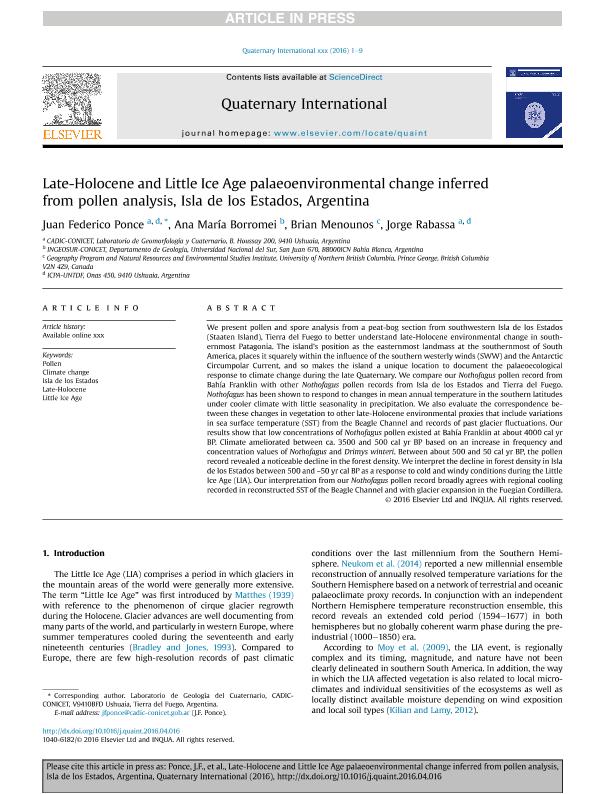Mostrar el registro sencillo del ítem
dc.contributor.author
Ponce, Juan Federico

dc.contributor.author
Borromei, Ana Maria

dc.contributor.author
Menounos, Brian

dc.contributor.author
Rabassa, Jorge Oscar

dc.date.available
2018-09-06T20:59:11Z
dc.date.issued
2017-06-23
dc.identifier.citation
Ponce, Juan Federico; Borromei, Ana Maria; Menounos, Brian; Rabassa, Jorge Oscar; Late-Holocene and Little Ice Age palaeoenvironmental change inferred from pollen analysis, Isla de los Estados, Argentina; Pergamon-Elsevier Science Ltd; Quaternary International; 442; Parte A; 23-6-2017; 26-34
dc.identifier.issn
1040-6182
dc.identifier.uri
http://hdl.handle.net/11336/58637
dc.description.abstract
We present pollen and spore analysis from a peat-bog section from southwestern Isla de los Estados (Staaten Island), Tierra del Fuego to better understand late-Holocene environmental change in southernmost Patagonia. The island's position as the easternmost landmass at the southernmost of South America, places it squarely within the influence of the southern westerly winds (SWW) and the Antarctic Circumpolar Current, and so makes the island a unique location to document the palaeoecological response to climate change during the late Quaternary. We compare our Nothofagus pollen record from Bahía Franklin with other Nothofagus pollen records from Isla de los Estados and Tierra del Fuego. Nothofagus has been shown to respond to changes in mean annual temperature in the southern latitudes under cooler climate with little seasonality in precipitation. We also evaluate the correspondence between these changes in vegetation to other late-Holocene environmental proxies that include variations in sea surface temperature (SST) from the Beagle Channel and records of past glacier fluctuations. Our results show that low concentrations of Nothofagus pollen existed at Bahía Franklin at about 4000 cal yr BP. Climate ameliorated between ca. 3500 and 500 cal yr BP based on an increase in frequency and concentration values of Nothofagus and Drimys winteri. Between about 500 and 50 cal yr BP, the pollen record revealed a noticeable decline in the forest density. We interpret the decline in forest density in Isla de los Estados between 500 and ∼50 yr cal BP as a response to cold and windy conditions during the Little Ice Age (LIA). Our interpretation from our Nothofagus pollen record broadly agrees with regional cooling recorded in reconstructed SST of the Beagle Channel and with glacier expansion in the Fuegian Cordillera.
dc.format
application/pdf
dc.language.iso
eng
dc.publisher
Pergamon-Elsevier Science Ltd

dc.rights
info:eu-repo/semantics/openAccess
dc.rights.uri
https://creativecommons.org/licenses/by-nc-sa/2.5/ar/
dc.subject
POLLEN
dc.subject
CLIMATE CHANGE
dc.subject
ISLA DE LOS ESTADOS
dc.subject
LATE HOLOCENE
dc.subject
LITTLE ICE AGE
dc.subject.classification
Paleontología

dc.subject.classification
Ciencias de la Tierra y relacionadas con el Medio Ambiente

dc.subject.classification
CIENCIAS NATURALES Y EXACTAS

dc.subject.classification
Otras Ciencias de la Tierra y relacionadas con el Medio Ambiente

dc.subject.classification
Ciencias de la Tierra y relacionadas con el Medio Ambiente

dc.subject.classification
CIENCIAS NATURALES Y EXACTAS

dc.title
Late-Holocene and Little Ice Age palaeoenvironmental change inferred from pollen analysis, Isla de los Estados, Argentina
dc.type
info:eu-repo/semantics/article
dc.type
info:ar-repo/semantics/artículo
dc.type
info:eu-repo/semantics/publishedVersion
dc.date.updated
2018-09-04T16:52:39Z
dc.journal.volume
442
dc.journal.number
Parte A
dc.journal.pagination
26-34
dc.journal.pais
Estados Unidos

dc.journal.ciudad
Nueva York
dc.description.fil
Fil: Ponce, Juan Federico. Consejo Nacional de Investigaciones Científicas y Técnicas. Centro Austral de Investigaciones Científicas; Argentina. Universidad Nacional de Tierra del Fuego, Antártida e Islas del Atlántico Sur. Instituto de Ciencias Polares, Recursos Naturales y Ambiente. Departamento de Biología; Argentina
dc.description.fil
Fil: Borromei, Ana Maria. Consejo Nacional de Investigaciones Científicas y Técnicas. Centro Científico Tecnológico Conicet - Bahía Blanca. Instituto Geológico del Sur. Universidad Nacional del Sur. Departamento de Geología. Instituto Geológico del Sur; Argentina
dc.description.fil
Fil: Menounos, Brian. University of Northern British Columbia; Estados Unidos
dc.description.fil
Fil: Rabassa, Jorge Oscar. Consejo Nacional de Investigaciones Científicas y Técnicas. Centro Austral de Investigaciones Científicas; Argentina. Universidad Nacional de Tierra del Fuego, Antártida e Islas del Atlántico Sur. Instituto de Ciencias Polares, Recursos Naturales y Ambiente. Departamento de Biología; Argentina
dc.journal.title
Quaternary International

dc.relation.alternativeid
info:eu-repo/semantics/altIdentifier/url/https://www.sciencedirect.com/science/article/pii/S1040618215301415
dc.relation.alternativeid
info:eu-repo/semantics/altIdentifier/doi/http://dx.doi.org/10.1016/j.quaint.2016.04.016
Archivos asociados
